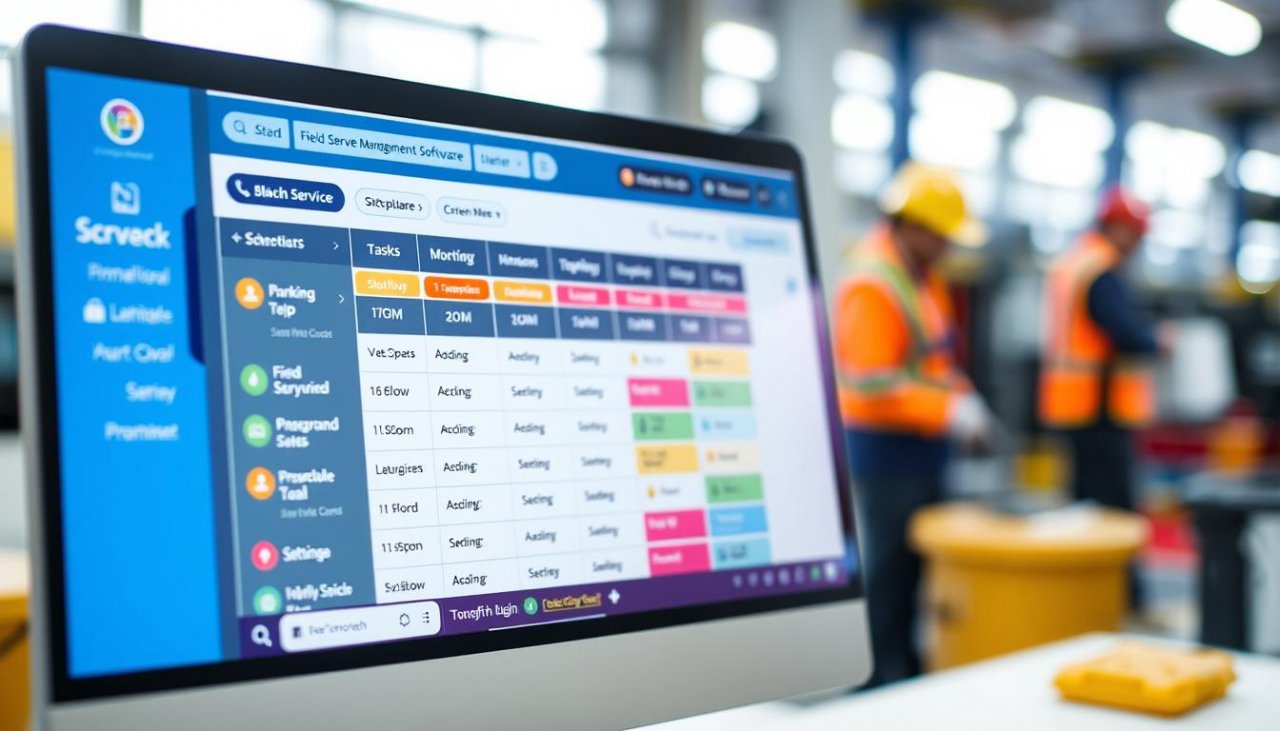When I first started with a new field service software for my team, I faced challenges. There was a mix of skepticism and confusion in the office. My team was set in their old ways, and the idea of a digital change was tough.
Yet, I knew it was crucial for our growth. The right training could turn a challenge into a big opportunity. So, I worked hard to create a simple training program that would engage and adapt my team.
The first step was to understand that my team needed more than just instructions. They needed a clear guide to the new software and support. It was important to make learning comfortable, where questions were welcome and every small win was celebrated.
By focusing on our team’s specific needs, we quickly made progress. What was once confusing became exciting and brought us closer together.

Key Takeaways
- Training is vital for a smooth digital transition.
- Engagement helps teams adapt to new software faster.
- Clear objectives can guide effective new software training.
- Real-time demonstrations enhance understanding and retention.
- Continuous support emphasizes learning and growth.
The Importance of Training in a Digital Transition
Training is key in a digital shift. It gives me and my team the skills to use new tech smoothly. Without it, we might struggle to bring services together, slowing us down. I’ve seen how important it is to keep learning as tech changes fast.
The full benefits of field service automation software shine when users know what it can do. Service management software training makes me see its worth for our work.
Feeling sure of myself makes me less scared of change. Training helps us all get better at using new tools. This makes us work better and happier.
Understanding Your New Field Service Software
Before starting training, it’s key to understand the new field service software’s features and how it works. Knowing the best field service software for SMEs helps me see how it fits into daily tasks. I look at the user interface, how to navigate it, and key features that make a big difference.
Choosing the right field service tool is very important. A tool that’s easy to use and navigate boosts productivity and builds team confidence. It’s also vital to look at affordable options for small to medium-sized businesses. These tools have features that meet specific business needs, making sure every part of field service management is covered.
Knowing the field of the best field service software for SMEs means seeing the differences among tools. Each tool has unique abilities that help businesses manage better. The right software helps teams provide top-notch service and use resources well, making work smooth in the field.
Designing an Effective Training Program
Creating a good training program is key for any company bringing in new tech like field service software. I start with clear goals to make the process easier. These goals should show what skills I want my team to get and match our business aims. This makes the training clear and keeps everyone on track.
Setting Clear Objectives
Setting clear goals for our training shows what we aim to achieve. Each goal should be specific, measurable, attainable, relevant, and time-bound. This makes a solid plan for success. By knowing what good training looks like, I can make sure the learning fills in skill gaps often missed in other programs.
Choosing the Right Training Format
Next, picking the right training format is important for our team. We can choose from in-person workshops or flexible online training that fits our busy lives. Mixing different ways of learning helps everyone learn better. Adding interactive learning makes the training more engaging and helps my team use what they learn in real situations.

Utilizing Real-time Demonstrations
Real-time software demonstrations are a great way for my team to learn about our new field service app. They get to see the software work right before their eyes. This helps them understand its features and how to use it better.
Hands-on training with real-time demos improves how well they remember and understand the software. They don’t just watch; they get to try it out. This makes learning feel more real and important.
I suggest making these sessions relevant to real-life situations. Showing them how to use the app for tasks they’ll do helps with problem-solving. It makes learning easier and more fun.
This method makes the app’s complex features simpler. It turns a tough learning process into a team effort. Everyone supports and helps each other.
Leveraging Field Service Software for SMEs
Running a small or medium enterprise (SME) comes with its own set of challenges, like managing cash flow and getting supplies. Using field service software can turn these challenges into benefits. This software helps make operations more efficient, improves customer happiness, and makes managing services easier. It also automates tasks and schedules, saving time and resources.
Benefits for Small and Medium Enterprises
Field service software offers big perks, like access to financing options usually for big companies. For instance, small businesses can now get Net 30 terms, helping with cash flow. This lets me invest in marketing or growing my inventory, setting my business up for growth.
By paying bills on time, I build trust with suppliers. This trust leads to better prices and terms, making my business more profitable.
How to Maximize Your Investment
To get the most out of software, it’s key to use its features well. I focus on automating tasks to boost productivity. Training my team on these tools ensures they use them right.
Good financial management helps avoid late fees and keeps credit scores healthy. By embracing this technology, I keep up with AI and service management advancements for ongoing growth.
Incorporating Interactive Learning Techniques
Getting teams involved in training is key. Using interactive learning methods can really change the game. Techniques like group talks, simulation exercises, and games make learning more fun and effective. They help bridge the gap between theory and real-world use, especially with an SME field service tool.
Interactive learning lets trainees practice what they’ll do on the job. It promotes teamwork and helps them understand the software better. I’ve seen that hands-on activities make learners more excited and better at using new tools. Interactive methods make learning a new system easier and fun.
Providing Continuous Support and Resources
Creating a supportive environment for field service software training is key. I’ve seen how important ongoing support is for team members. They feel more at ease asking for help after the initial training.
Quick reference guides and video tutorials are great tools for users. They can easily find help when they need it. Having a dedicated support team also helps a lot. They provide answers and bridge the gap between training and real-world use.
Training is not just a one-time thing; it’s a continuous journey. Regular follow-up sessions are important. They help reinforce what was learned and adapt to software updates.
This keeps employees skilled and confident in their work. With ongoing support and resources, my team has seen big improvements in productivity and satisfaction.
Team Engagement and Motivation During the Training
Keeping my team engaged and motivated is key for good results. When I make the learning space positive, people feel more confident and care more about the process. I use different methods to create a supportive and encouraging atmosphere. This boosts team spirit and makes learning easier.
Fostering a Positive Learning Environment
For a positive learning space, I focus on encouragement and community. I highlight how important it is to recognize each other’s efforts. When we celebrate our wins, big or small, everyone feels they belong. This makes the team work better together and towards common goals.
Recognizing and Celebrating Milestones
Celebrating big and small wins keeps the team motivated. By giving out awards, I push my team to aim higher. These awards not only praise their hard work but also set goals for others. This makes our team more supportive and helps everyone do better.
Evaluating Training Effectiveness
When it comes to training programs, I believe that evaluating training effectiveness is key. It makes sure my team’s training meets its goals. Using effectiveness metrics shows how well people learn the material. This can be done through surveys and performance checks.
Gathering training feedback helps us see what employees think and understand about the software. This makes improving the training easier. By focusing on how the training affects real work, I can see its impact better.
Regularly updating training based on feedback keeps it fresh and useful. This way, the training stays relevant and helps everyone involved.

Conclusion
As we conclude our exploration of field service software for SMEs, it’s clear that effective training is key. I’ve discussed strategies that highlight the importance of structured training, interactive learning, and ongoing support. These are vital for a smooth transition to new technologies, especially for small and medium businesses.
It’s not just about learning new software; it’s about building a culture of learning and flexibility. By investing in thorough training, businesses can boost their efficiency, manage cash flow better, and strengthen supplier relationships. Tools like CRM analytics can also improve how we interact and make decisions, helping SMEs stay competitive.
The key to success lies in a proactive approach to learning. By adopting these training methods, you’ll not only create a flexible team but also open doors to growth and stability in a changing business world.
See how FieldAx can transform your Field Operations.
Try it today! Book Demo
You are one click away from your customized FieldAx Demo!
FAQ
What is the best field service software for SMEs?
For SMEs, the top field service software is affordable and has features made for small to medium businesses. It should have strong service management, be easy to use, and have great customer support.
How do I train my team on new field service software?
Start by making a training plan with clear goals. Choose the best way to train and include practical examples. Use interactive methods to keep everyone interested and help them remember more.
Why is training essential for a digital transition?
Training is key for a digital shift because it teaches your team how to use the new software well. It makes them more confident and less hesitant to change, making it easier to adopt the new software.
What are effective interactive learning techniques for field service training?
Good ways to make training interactive include group talks, simulations, and games. Using the field service tool in real situations helps connect theory with what happens in the real world.
How can I provide ongoing support after training?
Offer ongoing support with a resource center, quick guides, videos, and a support team. Have regular check-ins to make sure learning sticks and keep employees informed about new features.
How can I motivate my team during training?
Keep your team motivated by creating a positive learning space. Celebrate their achievements and value their input. Use leader support and praise from peers to keep spirits high during training.
What metrics should I use to evaluate training effectiveness?
Use feedback from participants, check how well they perform, and look at how they use the software. Update training based on what people say to keep improving it.
Author Bio
Co-Founder & CMO at Merfantz Technologies Pvt Ltd | Marketing Manager for FieldAx Field Service Software | Salesforce All-Star Ranger and Community Contributor | Salesforce Content Creation for Knowledge Sharing






